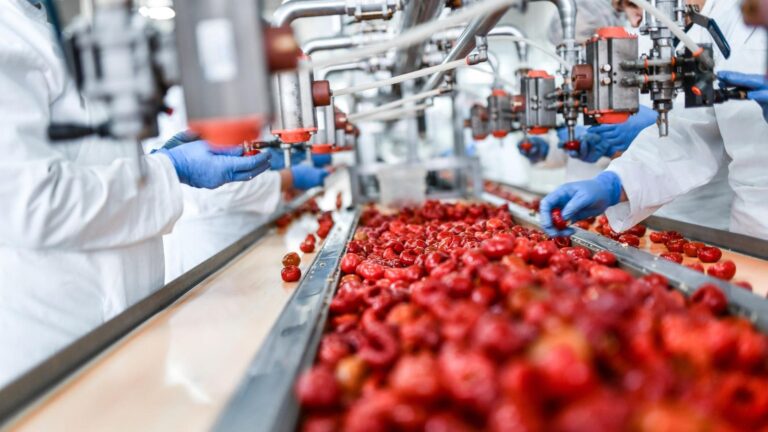Cherry pepper pitting process in a food processing factory
One of the science and technology trends I’m watching right now is how scientists are developing CRISPR genome editing technology. Once fully developed, it will have a dramatic impact on food manufacturers, agriculture, and consumers. Many communities are unable to produce enough food for their residents due to natural disasters, climate change, and other disruptive factors. But food security is not the only area of importance. This technology will have a significant impact on several industries, especially the healthcare and pharmaceutical industries. There is no doubt that this technology will be disruptive and transformative if it enters the mainstream market. What should we understand about how this technology may impact our business?
As I explained in last week’s blog, “Predicting the Next Disruptive Technology is Hard, But Essential,” companies face existential threats if they fail to correctly anticipate technological change and then make the necessary adjustments and investments to take advantage of that change.
What is CRISPR genome editing?
CRISPR genome editing is the field of synthetic foods, or foods made from ingredients that don’t come from farms. An entire ecosystem of synthetic foods is now forming because farmland is scarce in many parts of the world due to natural disasters, climate change, and other environmental issues.
CRISPER editing uses large-scale computational techniques to create highly specific genetic access to crop plants: creating unique genomes to engineer plants.
CRISPR editing has been used in the past to genetically modify crops for pest resistance, and now there’s a market for it for companies wanting to continuously supply the world with non-animal protein foods.
Innovation with CRISPR Genome Editing
Last week I spoke with Everest Group Managing Partner Richard Sear about the development of CRISPER genome editing for food innovation, and he told me that the current goal is to create new varieties of edible plants.
“The goal is to promote the use of nutraceuticals and create health foods by incorporating pharmacological products into food. Many existing food ingredients are not suitable for infusion into nutraceuticals,” says Richard.
“For example, someone with heart disease could not previously eat a chocolate bar, but with our new product, the drug is chemically embedded in the chocolate bar so they can take their heart medication at the same time.”
Is there such thing as a healthy chocolate bar? A Google search for that question turns up several recent articles on the topic, as well as companies promoting their products.
Richard comments: “If the cocoa bean is artificial, can other substances, such as medicines, be added to the chocolate bar without compromising the taste? And can this be reduced in a way that reduces the risk of weight gain or other harm to people who eat a regular chocolate bar?”
As food companies and individuals, we need to think about future food security. If new foods could be created through CRISPR genome editing, would they be welcomed? Under what conditions would people be happy to eat such foods?
Would such foods be productive and eco-efficient? According to Richard, most of the research being done with CRISPR as an engineering technology for food security focuses on these issues and the quality aspects of nutraceutical innovation.
When can it be put on the market?
What remains to be accomplished on the road to bringing CRISPR genome editing technology to market and changing the way seeds are created? Will it ever actually make it to market?
Social acceptability is one of the factors scientists are currently tracking in the development of this technology. Some may have religious or ethical concerns. Would people be willing to eat such food?
There is also strong regulatory resistance to this technology in some countries. China and Europe have much stricter regulatory environments and are less open to innovation, while the United States has more lax regulations and is more disruptive to innovation. These differences in regulatory environments will have a major impact on both where these technologies are developed and how these innovations are accepted by consumers.
Companies that want to track the development of this new technology and understand when it may disrupt their industry or business should leverage the ability to track every component of the development and incorporate it into a forecast timeline scenario, so they can understand the constraints that affect it and be confident about whether and when to invest.
Evolving regulatory and legislative trends and societal acceptance are two of these factors.
There are four stages in the development of CRISPR editing. Most of the issues in the first three stages have been resolved. Two areas in the fourth stage still need to be resolved.
1. Building and running the models requires a huge amount of computing power.
2. Scientists currently lack enough actionable data.
Numeracy problems. Currently, we are constrained by the size of data centers and their ability to build and operate that computing power at the scale required to drive our models. We need to move from simple to more complex models and build enough computing power to be able to use it across a wider range of plants and proteins.
Additionally, computing power needs to be available to a wide range of people at a reasonable price that is useful at the scale at which models can be developed and run.
There is not enough data. Currently, there is not enough data set to build and deploy scale models. Richard explains that there is limited information to understand the genetics of the plants because crop yields are not yet high enough.
But make no mistake: CRISPR genome editing is coming, and it will be disruptive.

